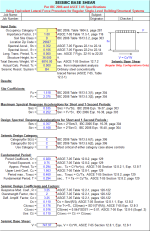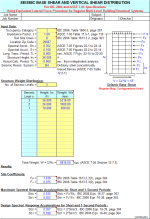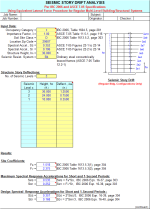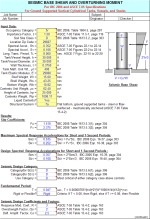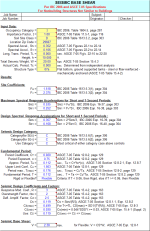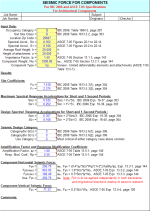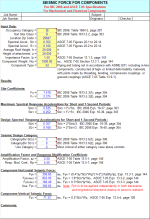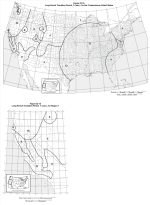IBC2006E.xls
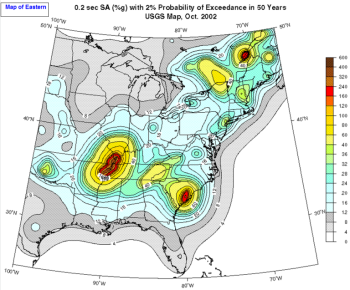
Description
"IBC2006E" is a spreadsheet program written in MS-Excel for the purpose of seismic loading analysis for buildings and various nonbuilding structures, as well as architectural, mechanical, and electrical components per the IBC 2006 and ASCE 7-05 Codes. Specifically, the total base seismic shear for buildings and nonbuilding structures is calculated. For Multi-Level Buildings, the vertical distribution of the total seismic shear is also determined, and a drift analysis can also be performed.. The seismic restraint force for various components is also calculated.
This program is a workbook consisting of eleven (11) worksheets, described as follows:
Worksheet NameDescription
Doc - This documentation sheet
Single-Level Bldg. - Seismic base shear for single-level buildings
Multi-Level Bldg. - Seismic base shear and vertical shear distribution for multi-level buildings
Multi-Level Bldg. (Drift) - Seismic story drift analysis for multi-level buildings
Vert. Tank or Vessel - Seismic base shear and overturning moment for vertical tanks/vessels
Nonbldg. Struct. - Seismic base shear for nonbuilding structures
Arch. Components - Seismic forces for architectural components
M & E Components - Seismic forces for mechanical and electrical components
Maps for Ss - 2002 USGS maps for 0.2 sec. spectral acceleration with 2% P.E.
Maps for S1 - 2002 USGS maps for 1.0 sec. spectral acceleration with 2% P.E.
Maps for TL - ASCE 7-05 Code maps for Long-Period Transition Period
Program Assumptions and Limitations:
1. This program uses the IBC 2006 Code only to determine the Seismic Design Category, while IBC 2006 Code Section 1613.1 permits the Seismic Design Category to be determined by either IBC 2006 or ASCE 7-05. For all practical purposes, beyond determining the Seismic Design Category, the IBC 2006 Code now defers to the ASCE 7-05 Code for seismic analysis and design.
2. This program incorporates the changes provided in Supplement No. 2 to the ASCE 7-05 Code.
3. For buildings, the program assumes the use of the equivalent lateral-force method for analysis, per ASCE 7-05 Section 12.8. For nonbuilding structures, ASCE 7-05 Section 15.0 is followed. For architectural, mechanical, and electrical components, ASCE 7-05 Section 13.0 which is followed. The "simplified" method, per ASCE 7-05 Section 12.14 is not used in any of the calculation worksheets.
4. The program assumes "regular" buildings and structures, with plan and vertical irregularities not being considered. Refer to ASCE 7-05 Section 12.3 for building configuration, and plan and vertical irregularity criteria.
5. Worksheets for Multi-Level Buildings are applicable for buildings and structures up to 240 feet in height, with up to 15 levels. (Story deflections are to be determined from separate elastic 2D or 3D frame analysis.)
6. This program does not include the provisions for nonbuilding structures that are supported by other structures as per ASCE 7-05 Section 15.3.
7. Worksheets calculate for "gross" seismic shear force, and do not reflect the use of any load factors. Refer to ASCE 7-05 Section 12.4 for applicable loads factors for LRFD or strength design as well as ASD analysis.
8. USGS 2002 maps for the short term 0.2 sec. spectral acceleration (SA) with 2% Probability of Exceedance in 50 years, Ss, as well as the 1.0 sec. spectral acceleration (SA) with 2% Probability of Exceedance in 50 years, S1, are included. These maps are the 2002 "color versions" of Figures 22-1 and 22-2 from ASCE 7-05. Peak gravitational acceleration, PGA, is what is experienced by a particle on the ground. Response spectral acceleration, SA, is what is approximately experienced by a building, as modeled by a particle on a massless vertical rod having the same natural period of vibration as the building. The SA values shown in the USGS maps as well as the ASCE 7-05 Figures 22-1 through 22-14 are expressed as a percentage of "g", the acceleration due to gravity. Their numerical values should be divided by 100 to convert them into decimal form for use in the Code formulas and calculations. Note that there are "exploded" maps of various portions of continental U.S. included as well. These can be seen by scrolling down screen. (Note: while the USGS does have more current gridded design values for Ss and S1 available at their web site, the user is cautioned in their use as they are NOT officially adopted for use by the ASCE 7-05 Code. If their use would result in a lower Seismic Design Category and reduced seismic loads, the user is advised to seek formal approval of their use by the owner and building official if applicable.)
9. This program allows the user to select only site classes "A" through "E", since site class "F" requires site-specific geotechnical investigation and dynamic site response analyses. These same requirements also apply for site class "E", but only when Ss >= 1.25g and S1 >= 0.5g.
10. In the calculation worksheets, a "hyperlink" is provided to take the user directly to the USGS website at:
http://earthquake.usgs.gov/research/hazmaps/
Once finished at the USGS website, the user should exit the website by pressing the [<-Back] button in the top toolbar of the web browser to return to the particular program worksheet.
11. This program automatically selects the appropriate seismic response modifier, "R", once the type of seismic resisting system has been selected/input by the user.
12. This program will automatically alert the user with a "warning message" when any applicable limitations have been exceeded for the particular seismic resisting system selected.
13. This program contains numerous “comment boxes” which contain a wide variety of information including explanations of input or output items, equations used, data tables, etc. (Note: presence of a “comment box” is denoted by a “red triangle” in the upper right-hand corner of a cell. Merely move the mouse pointer to the desired cell to view the contents of that particular "comment box".)
Cross Reference Index between IBC 2006 and ASCE 7-05 Codes
SubjectIBC 2006ASCE 7-05
Occupancy CategoryTable 1604.5Table 1-1
Seismic Importance FactorDefers to ASCE 7-05Table 11.5-1
Mapped 0.2 Second Period Spectral Acceleration, SsFigure 1613.5(1)Figure 22-1
Mapped 1.0 Second Period Spectral Acceleration, S1Figure 1613.5(2)Figure 22-2
Site ClassTable 1613.5.2Table 20.3-1
Acceleration-based Site Coefficient, FaTable 1613.5.3(1)Table 11.4-1
Velocity-based Site Coefficient, FvTable 1613.5.3(2)Table 11.4-2
Maximum Spectral Response Acceleration, SMSEqn. 16-37Eqn. 11.4-1
Maximum Spectral Response Acceleration, SM1Eqn. 16-38Eqn. 11.4-2
Design Spectral Response Acceleration, SDSEqn. 16-39Eqn. 11.4-3
Design Spectral Response Acceleration, SD1Eqn. 16-40Eqn. 11.4-4
Seismic Design Category Using SDS and Occupancy Cat.Table 1613.5.6(1)Table 11.6-1
Seismic Design Category Using SD1 and Occupancy Cat.Table 1613.5.6(2)Table 11.6-2
Building ConfigurationDefers to ASCE 7-05Section 12.3.2
Permitted Analytical ProceduresDefers to ASCE 7-05Table 12.6-1
Seismic Load Effects , E and EmDefers to ASCE 7-05Section 12.4
RedundancyDefers to ASCE 7-05Section 12.3.4
Deflection and Drift LimitsDefers to ASCE 7-05Section 12.12
Equivalent Lateral Force ProcedureDefers to ASCE 7-05Section 12.8
Seismic Force Resisting SystemsDefers to ASCE 7-05Section 12.2.1
Seismic Force Resisting System Coefficients and FactorsDefers to ASCE 7-05Table 12.2-1
Architectural, Mechanical, and Electrical ComponentsDefers to ASCE 7-05Section 13.0
Nonbuilding StructuresDefers to ASCE 7-05Section 15.0
Note: Per IBC 2006 Section 1613.1, the Seismic Design Category is permitted to be determined by either the IBC
2006 or ASCE 7-05 Codes. For all practical purposes, beyond determining the Seismic Design Category, the
IBC 2006 Code now defers to the ASCE 7-05 Code for seismic analysis and design.
Calculation Preview
Full download access to any calculation is available to users with a paid or awarded subscription (XLC Pro).
Subscriptions are free to contributors to the site, alternatively they can be purchased.
Click here for information on subscriptions.
I also included an updated hyperlink to the USGS Earthquake Hazards website, as well as a hyperlink to the USGS Ground Motion Parameter Calculator, which may be freely downloaded and installed to aid in the determination of the seismic design parameters "Ss", "S1", etc.
I also made a few minor additions to illustrations, etc.
This workbook is now version 1.7.
The important thing is that the calculation logic for determining 'k' was correct, as the errors were only in the displayed text.
The current version is now 1.5.
Fortunately I did not have this typo error in the actual Table 13.6-1 that is hidden with the calculations and referenced/used by the input pick box in cell C17. While this was a minor point and did not effect the calculations/results in any way, I still wanted to make the correction.
This workbook is now version 1.4.
The comment box in cell G69 had the correct values based on "Occupancy Category", but as I said, the allowable drift ratios that were listed in tabular form for the various seismic resisting systems in the hidden calculations were incorrectly presented. Also, note that the comment box in cell G69 states that the first category of structures listed in Table 12.12-1 is not utilized by the worksheet.
The important thing was that the reference table and page number from ASCE 7-05 was correctly displayed in the body of each of those 3 worksheets.
I did not change the version number of the workbook for these very minor changes. It is still version 1.2.
The corrections have been made and this workbook is now version 1.2.
The workbook is now version 1.1.

